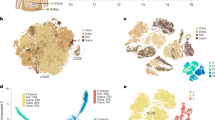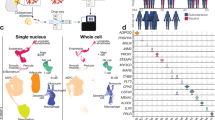Abstract
White adipose tissue displays high plasticity. We developed a system for the inducible, permanent labeling of mature adipocytes that we called the AdipoChaser mouse. We monitored adipogenesis during development, high-fat diet (HFD) feeding and cold exposure. During cold-induced 'browning' of subcutaneous fat, most 'beige' adipocytes stem from de novo–differentiated adipocytes. During HFD feeding, epididymal fat initiates adipogenesis after 4 weeks, whereas subcutaneous fat undergoes hypertrophy for a period of up to 12 weeks. Gonadal fat develops postnatally, whereas subcutaneous fat develops between embryonic days 14 and 18. Our results highlight the extensive differences in adipogenic potential in various fat depots.
This is a preview of subscription content, access via your institution
Access options
Subscribe to this journal
Receive 12 print issues and online access
$209.00 per year
only $17.42 per issue
Buy this article
- Purchase on Springer Link
- Instant access to full article PDF
Prices may be subject to local taxes which are calculated during checkout





Similar content being viewed by others
References
Abate, N., Garg, A., Peshock, R.M., Stray-Gundersen, J. & Grundy, S.M. Relationships of generalized and regional adiposity to insulin sensitivity in men. J. Clin. Invest. 96, 88–98 (1995).
Miyazaki, Y. & DeFronzo, R. Visceral fat dominant distribution in male type 2 diabetic patients is closely related to hepatic insulin resistance, irrespective of body type. Cardiovasc. Diabetol. 8, 44 (2009).
McLaughlin, T., Lamendola, C., Liu, A. & Abbasi, F. Preferential fat deposition in subcutaneous versus visceral depots is associated with insulin sensitivity. J. Clin. Endocrinol. Metab. 96, E1756–E1760 (2011).
Kim, J.-Y. et al. Obesity-associated improvements in metabolic profile through expansion of adipose tissue. J. Clin. Invest. 117, 2621–2637 (2007).
Kusminski, C.M. et al. MitoNEET-driven alterations in adipocyte mitochondrial activity reveal a crucial adaptive process that preserves insulin sensitivity in obesity. Nat. Med. 18, 1539–1549 (2012).
Sun, K., Kusminski, C.M. & Scherer, P.E. Adipose tissue remodeling and obesity. J. Clin. Invest. 121, 2094–2101 (2011).
Prins, J.B. & O'Rahilly, S. Regulation of adipose cell number in man. Clin. Sci. (Lond.) 92, 3–11 (1997).
Joe, A.W.B., Yi, L., Even, Y., Vogl, A.W. & Rossi, F.M.V. Depot-specific differences in adipogenic progenitor abundance and proliferative response to high-fat diet. Stem Cells 27, 2563–2570 (2009).
Jo, J. et al. Hypertrophy and/or hyperplasia: dynamics of adipose tissue growth. PLOS Comput. Biol. 5, e1000324 (2009).
Tang, W. et al. White fat progenitor cells reside in the adipose vasculature. Science 322, 583–586 (2008).
Rodeheffer, M.S., Birsoy, K.v. & Friedman, J.M. Identification of white adipocyte progenitor cells in vivo. Cell 135, 240–249 (2008).
Gupta, R.K. et al. Transcriptional control of preadipocyte determination by Zfp423. Nature 464, 619–623 (2010).
Gupta, R.K. et al. Zfp423 expression identifies committed preadipocytes and localizes to adipose endothelial and perivascular cells. Cell Metab. 15, 230–239 (2012).
Tran, K.-V. et al. The vascular endothelium of the adipose tissue gives rise to both white and brown fat cells. Cell Metab. 15, 222–229 (2012).
Wu, J. et al. Beige adipocytes are a distinct type of thermogenic fat cell in mouse and human. Cell 150, 366–376 (2012).
Lončar, D. Convertible adipose tissue in mice. Cell Tissue Res. 266, 149–161 (1991).
Loncar, D., Afzelius, B.A. & Cannon, B. Epididymal white adipose tissue after cold stress in rats. I. Nonmitochondrial changes. J. Ultrastruct. Mol. Struct. Res. 101, 109–122 (1988).
van Marken Lichtenbelt, W.D. et al. Cold-activated brown adipose tissue in healthy men. N. Engl. J. Med. 360, 1500–1508 (2009).
Frontini, A. & Cinti, S. Distribution and development of brown adipocytes in the murine and human adipose organ. Cell Metab. 11, 253–256 (2010).
Seale, P. et al. PRDM16 controls a brown fat/skeletal muscle switch. Nature 454, 961–967 (2008).
Lee, Y.-H., Petkova, A.P., Mottillo, E.P. & Granneman, J.G. In vivo identification of bipotential adipocyte progenitors recruited by 23-adrenoceptor activation and high-fat feeding. Cell Metab. 15, 480–491 (2012).
Himms-Hagen, J. et al. Multilocular fat cells in WAT of CL-316243–treated rats derive directly from white adipocytes. Am. J. Physiol. Cell Physiol. 279, C670–C681 (2000).
Granneman, J.G., Li, P., Zhu, Z. & Lu, Y. Metabolic and cellular plasticity in white adipose tissue I: effects of β3-adrenergic receptor activation. Am. J. Physiol. Endocrinol. Metab. 289, E608–E616 (2005).
Barbatelli, G. et al. The emergence of cold-induced brown adipocytes in mouse white fat depots is determined predominantly by white to brown adipocyte transdifferentiation. Am. J. Physiol. Endocrinol. Metab. 298, E1244–E1253 (2010).
Birsoy, K. et al. Analysis of gene networks in white adipose tissue development reveals a role for ETS2 in adipogenesis. Development 138, 4709–4719 (2011).
Sun, K. et al. Dichotomous effects of VEGF-A on adipose tissue dysfunction. Proc. Natl. Acad. Sci. USA 109, 5874–5879 (2012).
Perl, A.-K.T., Wert, S.E., Nagy, A., Lobe, C.G. & Whitsett, J.A. Early restriction of peripheral and proximal cell lineages during formation of the lung. Proc. Natl. Acad. Sci. USA 99, 10482–10487 (2002).
Soriano, P. Generalized lacZ expression with the ROSA26 Cre reporter strain. Nat. Genet. 21, 70–71 (1999).
Sharp, L.Z. et al. Human BAT possesses molecular signatures that resemble beige/brite cells. PLoS ONE 7, e49452 (2012).
Rosenwald, M., Perdikari, A., Rulicke, T. & Wolfrum, C. Bi-directional interconversion of brite and white adipocytes. Nat. Cell Biol. 15, 659–667 (2013).
Spalding, K.L. et al. Dynamics of fat cell turnover in humans. Nature 453, 783–787 (2008).
Miller, W.H. & Faust, I.M. Alterations in rat adipose tissue morphology induced by a low-temperature environment. Am. J. Physiol. 242, E93–E96 (1982).
Gesta, S., Tseng, Y.-H. & Kahn, C.R. Developmental origin of fat: tracking obesity to its source. Cell 131, 242–256 (2007).
Cartwright, M.J., Tchkonia, T. & Kirkland, J.L. Aging in adipocytes: potential impact of inherent, depot-specific mechanisms. Exp. Gerontol. 42, 463–471 (2007).
Macotela, Y. et al. Intrinsic differences in adipocyte precursor cells from different white fat depots. Diabetes 61, 1691–1699 (2012).
Tchkonia, T. et al. Fat depot origin affects adipogenesis in primary cultured and cloned human preadipocytes. Am. J. Physiol. Regul. Integr. Comp. Physiol. 282, R1286–R1296 (2002).
Baglioni, S. et al. Functional differences in visceral and subcutaneous fat pads originate from differences in the adipose stem cell. PLoS ONE 7, e36569 (2012).
Vega, G.L. et al. Influence of body fat content and distribution on variation in metabolic risk. J. Clin. Endocrinol. Metab. 91, 4459–4466 (2006).
Grundy, S.M., Adams-Huet, B. & Vega, G.L. Variable contributions of fat content and distribution to metabolic syndrome risk factors. Metab. Syndr. Relat. Disord. 6, 281–288 (2008).
Acknowledgements
We thank the University of Texas Southwestern Histology Core for assistance in embedding and processing tissue samples, especially J.M. Shelton for suggestions and discussions on the protocol of LacZ staining of adipose tissues. We also thank A.S. Greenberg from Tufts University for providing perilipin antibody. This study was supported by US National Institutes of Health (NIH) grants R01-DK55758, P01-DK088761 and R01-DK099110 (P.E.S.). Q.A.W. is supported by a postdoctoral fellowship from the American Diabetes Association (7-11-MN-47). R.K.G. is supported by NIH grants K01-DK090120-02 and R03-DK099428 and the Searle Scholars Program (Chicago, Illinois).
Author information
Authors and Affiliations
Contributions
Q.A.W. designed and performed the experiments and wrote the manuscript. C.T. assisted with mouse experiments. R.K.G. and P.E.S. conceptualized and designed the study and wrote the manuscript.
Corresponding author
Ethics declarations
Competing interests
The authors declare no competing financial interests.
Supplementary information
Supplementary Text and Figures
Supplementary Figures 1–5 (PDF 497 kb)
Rights and permissions
About this article
Cite this article
Wang, Q., Tao, C., Gupta, R. et al. Tracking adipogenesis during white adipose tissue development, expansion and regeneration. Nat Med 19, 1338–1344 (2013). https://doi.org/10.1038/nm.3324
Received:
Accepted:
Published:
Issue Date:
DOI: https://doi.org/10.1038/nm.3324
This article is cited by
-
MIIP downregulation drives colorectal cancer progression through inducing peri-cancerous adipose tissue browning
Cell & Bioscience (2024)
-
White adipocyte dysfunction and obesity-associated pathologies in humans
Nature Reviews Molecular Cell Biology (2024)
-
M2 macrophages independently promote beige adipogenesis via blocking adipocyte Ets1
Nature Communications (2024)
-
Knockdown of ANGPTL4 inhibits adipogenesis of preadipocyte via autophagy
In Vitro Cellular & Developmental Biology - Animal (2024)
-
Adipogenic effects of Ostreae Testa water extract on white adipocytes
Molecular & Cellular Toxicology (2024)



